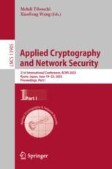Search
Search Results
-
Stratification of Hardware Attacks: Side Channel Attacks and Fault Injection Techniques
Cryptographic devices have many encrypted and secured solutions to protect them against hardware attacks. Hardware designers spent huge amount of...

-
Protecting Private Keys of Dilithium Using Hardware Transactional Memory
The confidentiality of cryptography keys is necessary in cryptographic implementations. In order to resist memory disclosure attacks that steal...
-
Using Analog Side Channels to Attack Cryptographic Implementations
This chapter overviews analog side-channel attacks on recent implementations of the two most popular public-key cryptography approaches, namely...
-
Unclonable Polymers and Their Cryptographic Applications
We propose a mechanism for generating and manipulating protein polymers to obtain a new type of consumable storage that exhibits intriguing...
-
Fast and Efficient Hardware Implementation of HQC
This work presents a hardware design for constant-time implementation of the HQC (Hamming Quasi-Cyclic) code-based key encapsulation mechanism. HQC...
-
Trojan playground: a reinforcement learning framework for hardware Trojan insertion and detection
Current hardware Trojan (HT) detection techniques are mostly developed based on a limited set of HT benchmarks. Existing HT benchmark circuits are...

-
An energy-efficient reconfigurable asymmetric modular cryptographic operation unit for RSA and ECC
RSA and ellipse curve cryptography (ECC) algorithms are widely used in authentication, data security, and access control. In this paper, we analyze...
-
Cryptographic Techniques
In order to establish a secure communication between two or multiple entities specific protocols need to be followed. To provide security the...
-
PUFchain 2.0: Hardware-Assisted Robust Blockchain for Sustainable Simultaneous Device and Data Security in Smart Healthcare
This article presents the first-ever hardware-assisted blockchain for simultaneously handling device and data security in smart healthcare. This...

-

-

-
Decomposition of Dillon’s APN Permutation with Efficient Hardware Implementation
Modern block ciphers incorporate a vectorial Boolean function (S-box) as their only nonlinear component. Almost Perfect Nonlinear (APN) functions...
-
Enhanced Security Mechanism for Cryptographic File Systems Using Trusted Computing
Trusted Computing Platform (TCP) using Trusted Platform Module (TPM) cryptographic microcontroller system was introduced by the Trusted Computing...
-
On-Demand Allocation of Cryptographic Computing Resource with Load Prediction
“Cryptography-as-a-Service” provides convenience for users to request cryptographic computing resources according to their needs. However, it also...
-
Trojan awakener: detecting dormant malicious hardware using laser logic state imaging (extended version)
The threat of (HTs) and their detection is a widely studied field. While the effort for inserting a Trojan into an (ASIC) can be considered...

-
How Hardened is Your Hardware? Guiding ChatGPT to Generate Secure Hardware Resistant to CWEs
The development of Artificial Intelligence (AI) based systems to automatically generate hardware systems has gained an impulse that aims to...
-
A comprehensive survey of physical and logic testing techniques for Hardware Trojan detection and prevention
Hardware Trojans have emerged as a great threat to the trustability of modern electronic systems. A deployed electronic system with one or more...

-
NoC-based hardware software co-design framework for dataflow thread management
Applications running in a large and complex manycore system can significantly benefit from adopting the dataflow model of computation. In a dataflow...

-
Formal Verification of Arithmetic Masking in Hardware and Software
Masking is a popular countermeasure to protect cryptographic implementations against physical attacks like differential power analysis. So far,...
